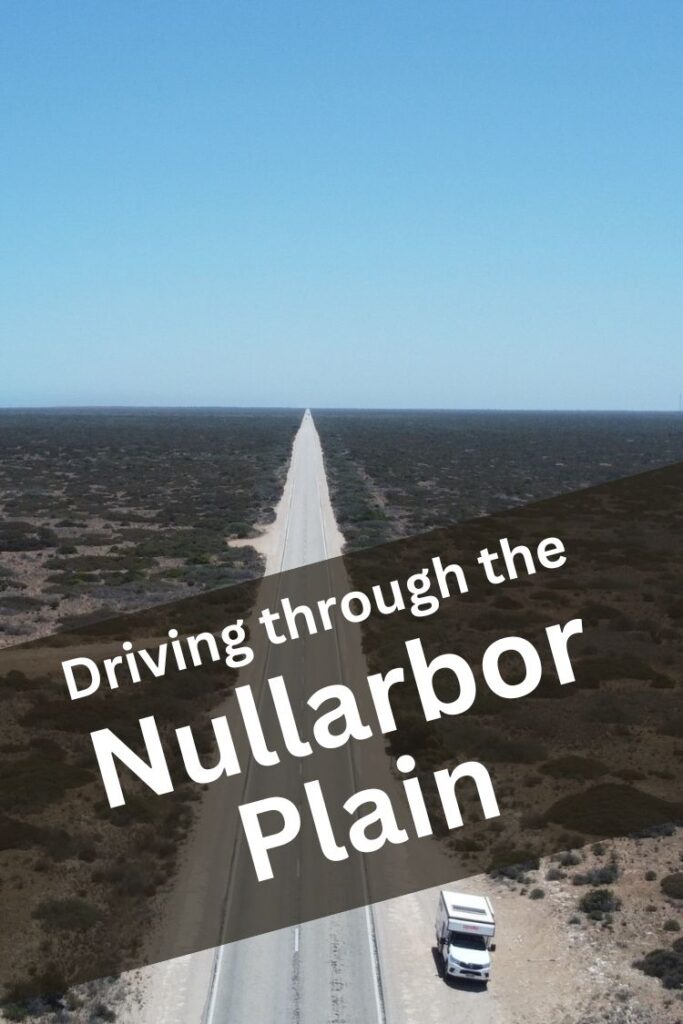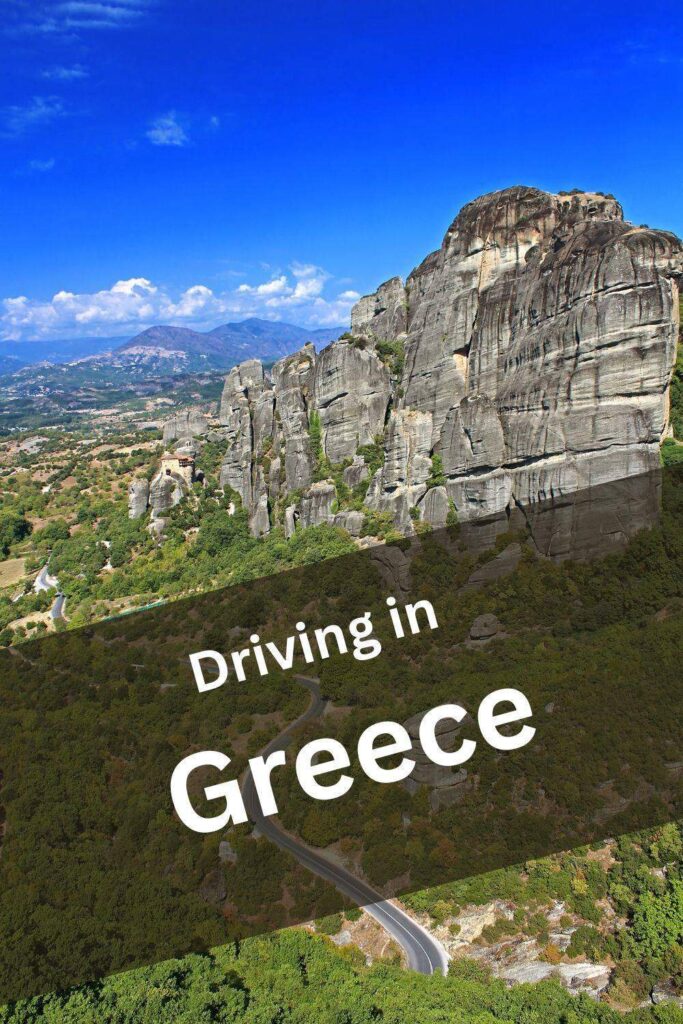This is a journey through the picturesque provinces of British Columbia and Alberta, crossing iconic roads such as the Sea to Sky Highway, the Trans Canada Highway and the most beautiful road of all: the Icefields Parkway. Stopping along the way in renowned national parks such as Jasper, Yoho, and Banff. Which is redundant: even staying in the car and seeing along the way the towering mountains, the immense forests, and the serene turquoise lakes is enough to create an unforgettable trip.
- Contents
- What to expect
- Tips & Impressions
- Overview
- Country Info
- Safety
- Getting around
- Weather
- Flora & Fauna
- Etiquette
- Itinerary
- Trip Stops
- Vancouver
- Capilano Suspension Bridge
- Sea to Sky Highway – Shannon Falls, Cheakamus Lake
- Whistler
- Joffre Lakes
- Duffey Lake
- Spahats Falls
- Jasper
- Maligne Lake
- Sunwapta Falls
- Icefields Parkway
- Peyto Lake
- Takakkaw Falls
- Lake Louise
- Banff
- Bow Falls
- Calgary
- Closing thoughts
Canada is one of those countries that simply inspires awe with its landscapes, the scale of which is hard to imagine until seen firsthand.
It is the second-largest country in the world and has more lakes than any other country. Forests, glaciers, infinite coast lines, badlands, and shrublands cover the massive extents of this wonderful, and mostly uninhabited, part of the North American continent.
Much like the United States or Australia, the country lends itself and almost demands to be visited by driving through parts of it, offering to its visitors the immense stretches of land that it holds.
My brief visit to Canada was just that: exploring the forests, lakes, and world-famous national parks while on the road. I covered some of the most famous roads in North America: the Sea to Sky Highway from Vancouver to Whistler, a miniscule part of the Trans Canada Highway going towards Jasper, and ending with one of the most beautiful roads I have ever been on: the Icefields Parkway cutting through perennial glaciers towards Banff.

What to expect
- Nature at its finest: untamed and unspoiled
- One of the safest countries in the world.
- Great wildlife. From whales on the coasts to black and grizzly bears in the forests Deer, elk, and moose Wolves, cougars, and iconic beavers
- Lakes, lakes, and more lakes: 20% of the world’s lakes are found in Canada. Perfect for canoeing and fishing.
- Large cosmopolitan cities that nonetheless maintain the feeling of a local town.
- A country made for hiking, camping, skiing, bird watching, and all other similar outdoor activities
- Crispy weather in summer and extreme cold in winter the further north you go.
- Immense spaces and landscapes. The country is the 2nd largest in the world and spans 6 time zones. Cities are spread apart and located mostly to the south. The further up north, the more wild and isolated it gets.
- World-renowned Canadian politeness.
- Quite expensive, especially in the major cities but also in the touristic areas surrounding the national parks.
Tips & Impressions
- Language: Hoping that no Canadian reads this (why would they? ), some things were downright funny. Visitors from the United States often make fun of the plastic and colorful “monopoly money” used in Canada, but since I come from Switzerland, where we also have brightly colored bills, that wasn’t a big deal. What I found amusing was how the Canadian dollar is known as the Loonie and their use of eh basically at every sentence, and of course the aboat accent. Other words were also silly to me, such as tobogganing for snow sledding and the Chinook wind (although this last one derives from an Inuit word). What I liked was the use of the word washroom instead of toilet, since I always felt the word to be slightly vulgar (not really sure why).
- Connectivity: It was expected and also welcomed, but I was somewhat surprised by the extent of the lack of connectivity when it comes to wireless and cellular. This was appreciated when it came to walking in the woods and admiring a lake, but I was quite on edge during the power outage caused by the wildfire in Jasper, when all gas stations were empty and there was no reception for hundreds of kilometers.
- Scenery: Although expected I must say that I wasn’t really prepared for the sheer size of the landscapes and the general isolation. The mountains and forests were beautiful and although I did not go on any particular hike and missed seeing a lot of wilderness, the views were amazing basically everywhere, even on the Trans-Canada highway outside of the national parks.
- Friendliness: Especially during the days of the power outage in Jasper, there was a particular sense of community and comradery. People would concern themselves with the well-being of others. But also in non-emergency situations, the general politeness and friendliness of everyone were very strong.
Overview
After having spent recent months on islands such as Fiji, Hawaii, and the US West Coast, I was keen to get some cooler temperatures and spend some time near glacial lakes, forests, and mountains.
Initially, I wanted to book a campervan or motorhome and travel this way as done in Australia, but the prices were forbidding, so I opted for a simple car and instead took an amazing Mazda 6 car and aimed to visit the Jasper, Yoho, and Banff national parks, as well as drive through the famous Icefields Parkway road.
The original plan was to do a lot of hikes. Unfortunately, because of a fire that created an area-wide power outage in the city of Jasper, all gas stations were out of service for several days, stopping me from going to the various locations in Jasper National Park.
In any case, I was in the mood to simply drive. Not sure if it was because of the nice car that I had hired instead of the usual beaten-up small rentals I usually take, or the quality of the roads, or some other inner desire and calling to have those introspective long drives within the vast stretches of land, but I enjoyed more driving through the areas and quickly stopping at the various landmarks rather than to actually do long hikes up mountains to get to a specific glacial lake where to spend the day.
See the Itinerary below for a detailed breakdown of every location
Country Info
- Language: Both English and French are the official languages, and depending on the area, one will be more predominant than the other.
- Population: 37+ million (2019)
- Ethnic Make-up: British Isles origin 28%, French origin 23%, other European 15%, Amerindian 2%, other, mostly Asian, African, Arab 6%, mixed background 26%
- Religion: 39% Catholic, 20.3% Protestant, 1.6% Orthodox, 3.2% Muslim, 1.5% Hindu, 1.4% Sikh, 1.1% Buddhist, 1% Jewish
- Government: Federal parliamentary democracy (Parliament of Canada) under a constitutional monarchy; a Commonwealth realm
- Currency: Canadian Dollar (CAD)
- Credit Cards: Much like in the US, credit cards are accepted almost anywhere. ATM availability outside cities is scarce.
- Electricity: Socket type B, 120 volt / 60 hertz
Check the Canada page for more country general information
Safety
- Safety: Canada is one of the safest countries in the world. It is more likely to have a bad encounter with a black bear (which is unlikely) than to be a victim of a violent crime.
- Natural risks: British Columbia and Yukon are prone to earthquakes, thus increasing the risk of tsunamis. Elsewhere, the predominant natural antagonist is the harsh cold weather and extreme temperatures, as well as floods. Because of this, the most probable natural risks are related to glaciers, hail, snow, and, in general, winter storms, which are quite common.
- Emergencies number: 911
Getting around
- Driving basics: Canadians drive on the right side of the road and use the metric system. As in other industrialized modern countries, the usual rules apply, such as pedestrians having the right of way, obeying speed limits, not driving under the influence, wearing mandatory seat belts, not using cell phones, etc. Also, in British Columbia, it is illegal to drive in neutral downhill to save fuel.
- Safety: Although I did not experience it firsthand, special care is needed in winter, as road conditions can drastically change and compromise driving safety. Winter tires, slow driving, and being on high alert for black ice are very important.
- Roads: Highways are generally in excellent condition. However, the temperature changes between winter and summer generate a lot of strain, creating potholes.
- Roadkill: Similarly to Australia, special attention must be given to possible (and likely) wildlife near the roads. Especially around dusk, animals such as deer can appear out of nowhere and often dart out in front of cars without much warning.
- Driving etiquette: As the cliché goes, the well mannered and respectful Canadians are so also on the road.
- Driving quirks: Also here, despite not having driven through Quebec, the province has some peculiarities. For example, sudden braking without cause will add two demerit points to a Canadian’s driving record; right turns on a red light are allowed there; or, by law, road signs cannot contain English text.
Check the Driving in Canada page for more driving tips and information
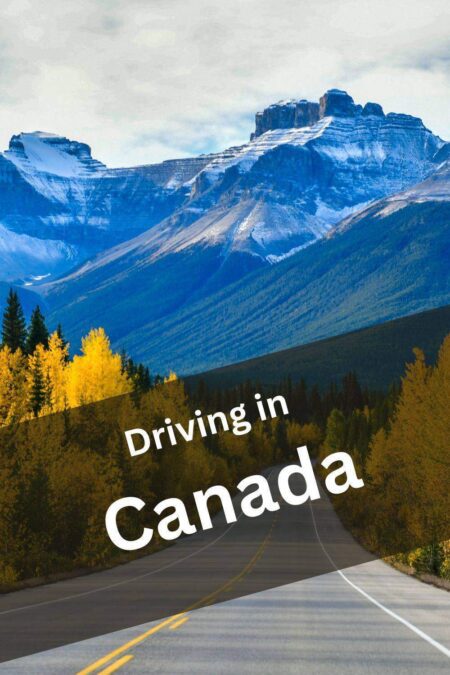
Weather
Being the second-largest country in the world, touching both the Atlantic and Pacific oceans, and having extensive mountain ranges, all kinds of climates can be experienced.
A best-time visit would entirely depend on the activities that one wishes to do. Home to some of the best ski resorts and generally the best winter sports locations in the world, winter may be ideal. On the other hand, the summer months are perfect for hiking in the mountains and visiting national parks and cities.
When it comes to risks, as mentioned in the safety section, winter may bring winter storms, while summer may bring extended periods of drought, which can cause floods in cases of sudden rain or generally consistent melting of ice caps.
Flora & Fauna
- Being such an immense country spanning half of the entire North American continent and with innumerable lakes and forests (around half of the country is composed of forests), wildlife in Canada is all over the place. In the south, there are ecosystems of rainforest and desert. The Rockies separate the south from the middle plains, while further north the environment changes to tundra, and the most northern regions lie above the Arctic Circle.
- With its immense forests, Canada is known for its giant resident mammals, most notably the iconic grizzly bear, and moose, but also bison, wild horse, beaver, fox, wolf, deer, and caribou. Region-specific animals such as the cougar or bald eagle in the prairies and the Rockies and polar bears to the north
- When it comes to marine life, the sheer number of lakes in the country makes it a paradise for salmon and trout. The Canadian Seas also have a huge population of whales, making the coastline a great destination for whale watching. To the north, killer whales can be regularly seen in their natural hunting environment.
- While most species that can be considered dangerous are mammals (e.g., wolves, bears, etc.), there is no shortage of reptiles and insects in Canada. Depending on the region, rainforests may bring black widow spiders, and the Badlands or other semi-arid shrublands may bring rattlesnakes and scorpions.
- While hiking, I did not spot any, but I have to admit I was very nervous about bear encounters. The few forest hikes I did on trails were constantly accompanied by a feeling of being on edge. The enjoyment of the natural sounds of the forest always carried with them some additional worry, definitely more than what would be needed in the woods and which was given by my inexperience.
Etiquette
- The stereotype of the “polite Canadian” is based on reality. As such, there are strong conventions on social behavior and etiquette. Canada has long used the term “just society” to emphasize egalitarianism and mutual respect. Generally speaking, it is about strong respect for others and the avoidance of behaviors that draw attention or that may be considered provocative. For example
- Given the diverse religions of the country, religious discourse in public is not common
- Similarly, political debates are usually not done in public. Even more with regards to highly charged themes such as those related to abortion, same-sex marriage, or racism, but also more simple political arguments on the government and general right/left political views.
- Punctuality is important in Canada and unexplained lateness is considered disrespectful
- All the above gives the idea that Canadians are much more indirect and modest when compared to their neighbors from the United States. Speaking of which, do not compare Canada to the United States.
- Discussions about French Canadians or the existence of francophones and anglophones are frowned upon.
- The same goes for Canadian Aboriginals. On that point, do not use the term “Native Americans” to refer to indigenous peoples, as many Canadians find the term offensive.
- Tipping is expected at a minimum of 15%.
- In the French part, citizens are slightly more affectionate and open, greeting themselves with two kisses on the cheeks, but generally speaking, Canadians do not like to be that open and tend not to touch, find it rude if someone speaks to them wearing hat or sunglasses or with their hands in their pockets, or is generally too outspoken and overtly friendly
Itinerary
Trip Stops
Vancouver
Vancouver

About
Vancouver is one of the most important cities in Canada. The third largest in the country but the first when it comes to population density, it is a major economic hub in western America. Its port is the busiest in Canada and an important link with eastern Asia. This and other aspects make it a very cosmopolitan city, with strong Asian influences due to its proximity to China (dubbing the city Hongcouver).
It is one of the most expensive cities in the world and is considered also one of the most liveable.
The city is immersed in nature and considered a haven for outdoor enthusiasts with its giant 400 hectares. Stanley Park and a short drive outside the city center allow one to go on hikes, ski in the mountains or hit the beach.
For more info on Vancouver check out this Article

Capilano Suspension Bridge
Capilano Suspension Bridge
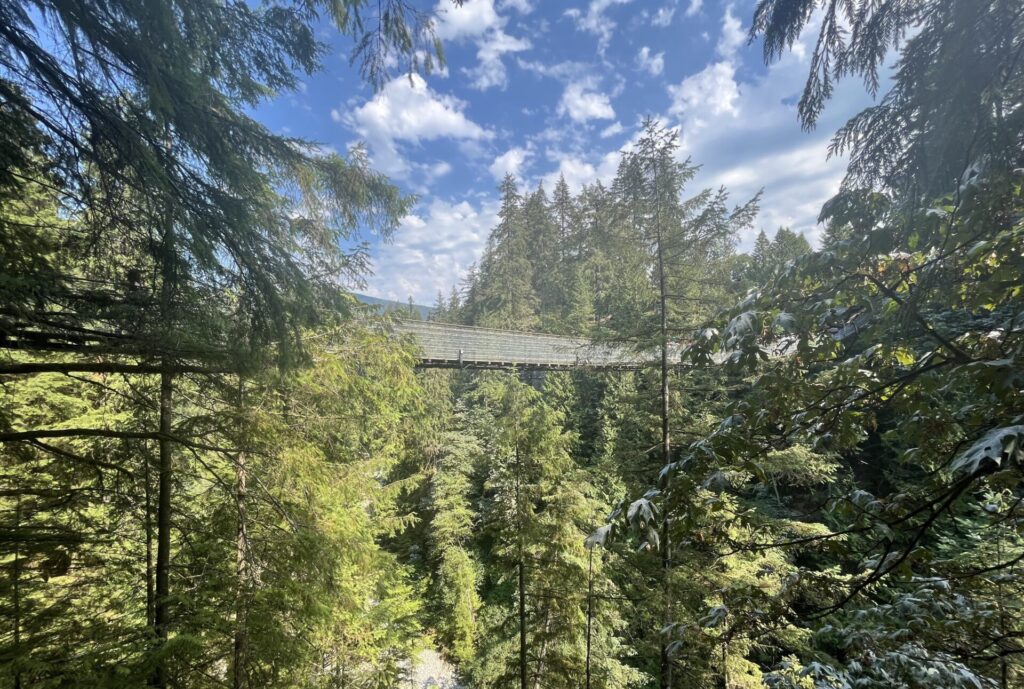
About
This pedestrian suspended bridge immersed in the forest just outside the city is a major tourist attraction. It stretches 140 meters long and is suspended 70 meters above the river.
Impressions
Being a simple suspended bridge, the more people traverse it, the more it sways, which arguably is part of the attraction, although I did not enjoy the people who would freak out from the fear of heights, those from the wobbling, and the “trolls” who would jump and sway to make the bridge oscillate even more.
Because of this, I simply traversed the bridge and spent much more time on the smaller ones in the forest, which were more enjoyable.
Sea to Sky Highway – Shannon Falls, Cheakamus Lake
Sea to Sky Highway – Shannon Falls, Cheakamus Lake
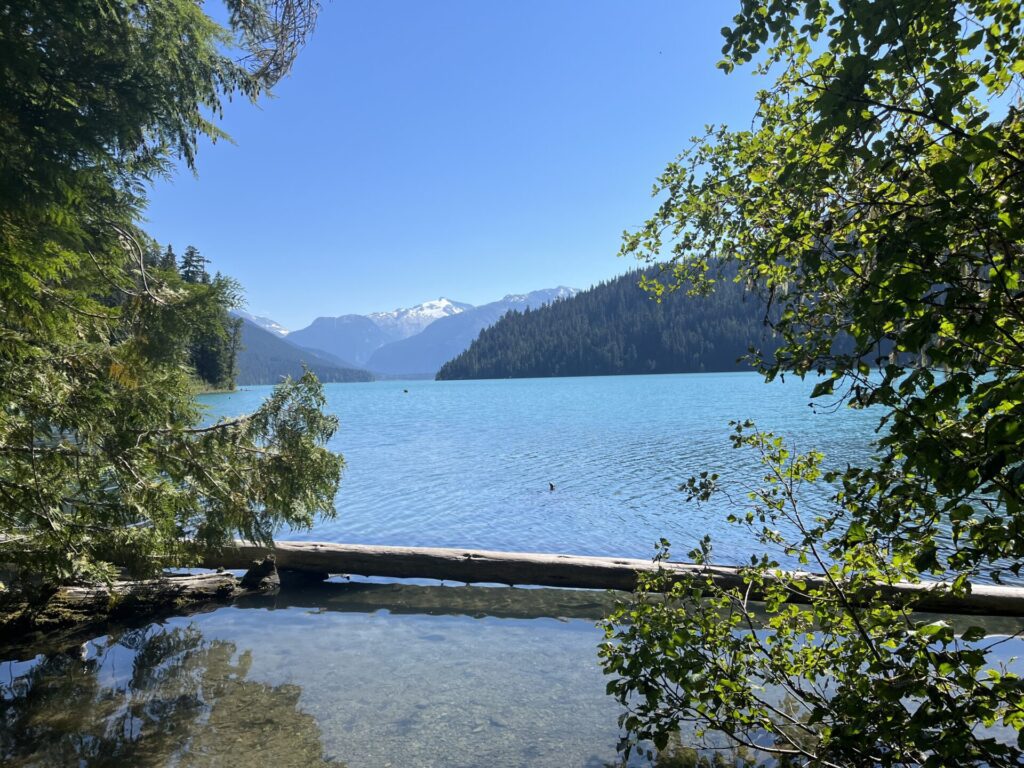
About
The Sea To Sky Highway (Highway 99) stretches from Vancouver to Pemberton, just north of Whistler.
It is a very scenic route that winds between the surrounding forest and traverses the Shannon Falls provincial park with the eponymous waterfalls. Shannon Falls are the third tallest in Canada, standing at 335 m.
Past Squamish is another famous park, Garibaldi Provincial Park, which hosts Cheakamus Lake, a beautiful secluded lake traversed on both ends by the river by the same name.
Drive
65km on the winding Sea to Sky Highway
Impressions
Shannon Falls was underwhelming because of the low amount of water and close proximity to the highway, making this a quick stop before proceeding.
On the other hand, the walk in the forest towards Cheakamus Lake was beautiful, with only one other couple of visitors encountered during the 1-hour hike. As stated before, I am used to hikes, but being a European, our forests are much more tame, and the bear warning signs on the way made me uneasy, and the sounds of nature were met with a different kind of attention.
That general concern was quickly swept away when I reached the secluded lake, where I spent a long time on the river bank and shore, taking a quick dip in the cold water. This was my first Canadian lake and I was simply amazed by its turquoise hue, the butterflies and fireflies flying everywhere, and since Cheakamus is traversed by the eponymous river on both sides, the constant gentle swaying of the water deflecting the sun rays.
Whistler
Whistler Blackcomb

About
The small town of Whistler, located at only 670 m elevation, boasts North America’s largest ski area: Whistler Blackcomb.
Host of the 2010 Winter Olympics, the hub of the town is a compact, chalet-style pedestrian village. 670 m elevation but
Although the town attracts most people during the winter, spring and summer are also important seasons thanks to the hikes and water sports that can be done in the area. Temperatures, as expected, are around 0°C but in summer they can reach as high as 20°C, changing completely the landscape and activities that can be done in the area.
Drive
60 km from Squamish on the winding Sea to Sky Highway.
Impressions
Whistler is an amazing small mountain town with a vibrant village. I initially thought that during the summer it would have been a sort of ghost town but there are a ton of activities.
When I arrived at the hotel, I was offered pamphlets, which were basically the size of encyclopedias. Mountain biking, running and hiking trails, peak-to-peak gondolas, dining, all sorts of kayaking and canoeing activities by the lakes, wildlife tours, and more
I instead spent the single day in the village on the many patios, soaking up the sun and cool temperature, and observing the passersby and calm environment of the surroundings.
Accommodation
I stayed in a wonderful condo apartment at Northstar at Stoney Creek ($$$$$) made of typical chalets, closely nestled under the mountains and right next to the village.
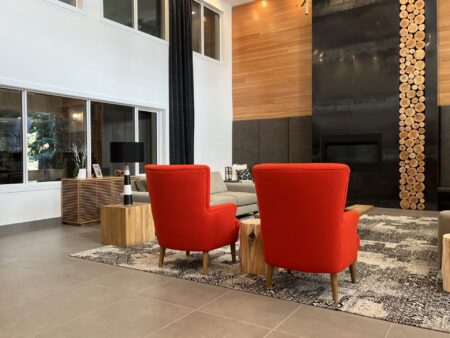
Deals for Whistler
Joffre Lakes
Joffre Lakes

About
Joffre Lakes are three famous lakes just outside Pemberton. The provincial park allows people to hike along the trail to reach the middle and upper lakes, each more spectacular and secluded than the previous.
As with many other glacial lakes, the rock flour in the water reflects blue and green waves, and gives the lakes a turquoise colour.
Drive
60 km from Whistler through Pemberton.
Impressions
Joffre Lakes are three famous lakes which showcase the typical aquamarine color given by the suspended glacial flour from the nearby mountains.
I skipped the other two lakes which are known to be better, if not for them being more secluded and leaving some of the visitors which do not want to do the hike behind, but my itinerary would have me go towards Kamloops which was a long drive.
The first lake was nonetheless beautiful – calm and peaceful and bathed by the warm summer rays.
Duffey Lake
Duffey Lake
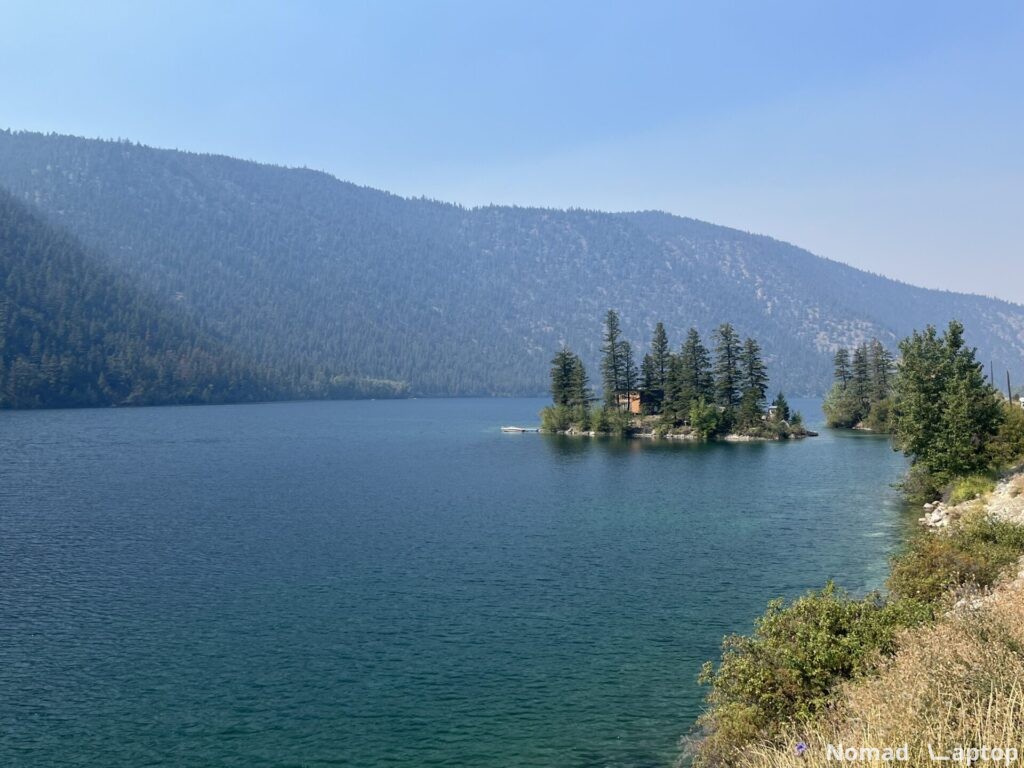
About
The road between Pemberton and Kamloops traverses the picturesque Duffey Lake and is overshadowed by Mt. Rohr.
The lake is a popular spot for canoeing, kayaking and wildlife viewing.
Drive
15kms from Joffre Lakes on Highway 99
Impressions
Between Pemberton and Lillooet lies the 100kms Duffey Lake Road.
I enjoyed this drive more than the Sea to Sky Highway to Squamish, as the wonderfully paved road gently coasts the lake and has ample spots to stop and admire the large body of water and surrounding nature.
Spahats Falls
Spahats Falls
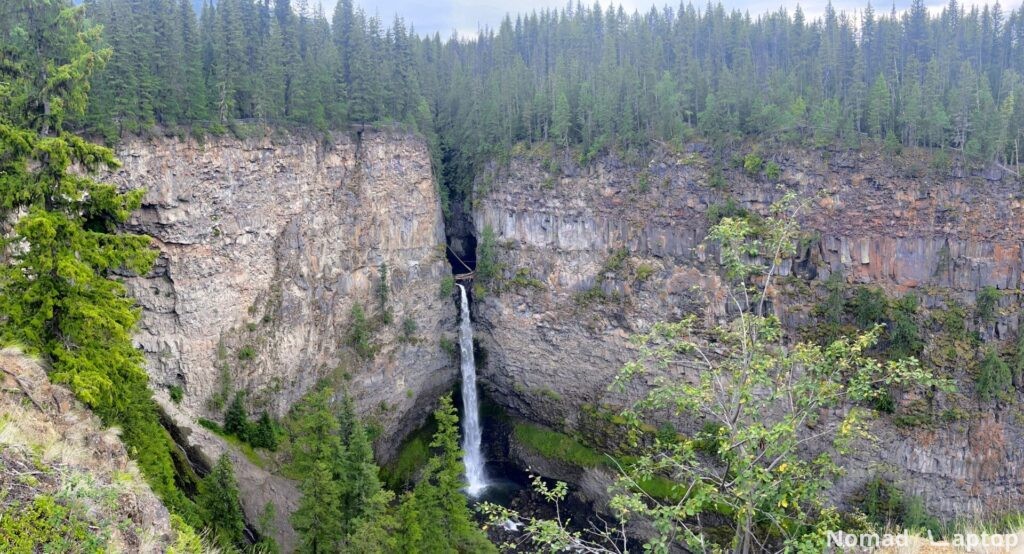
About
Spahats is the First Nations term for bear.
The waterfalls stand at 70 meters tall and are located within a huge basin that was initially formed by deposits of volcanic rock from numerous eruptions from Trophy Mountain around 300,000 years ago. The Clearwater River then created a stream that, during the Pleistocene, froze, carving and scraping the layers of lava.
Drive
220 km from Duffey Lake on Highway 99 towards the city of Kamloops.
Then north on Highway 5 for 135kms to Clearwater.
Impressions
Spahats Creek Falls was very surprising and after two days of long drives, this short stop filled me with awe. The observation deck on top of the cliffs of the immense canyon carved by the glacier allowed for a wonderful view of the entire gorge.
Jasper
Jasper

About
Like other national parks, there are a ton of things to do in Jasper National Park depending on the season, from icewalks and other excursions on glaciers or skiing in winter to hikes and wildlife watching and activities on the lakes and rivers such as rafting and canoeing in summer.
The town itself is the commercial and tourist center of the park and is a small mountain town with less than 5000 people. Most accommodations are small mountain lodges and cabins nestled within the surrounding forests.
Drive
330 km from Clearwater (Spahats Falls) on Highway 5
Impressions
After another long drive, I arrived in the town of Jasper and saw on the way a massive wild fire.
After I reached my mountain lodge, I discovered that the fire had created a power outage in the entire remote village, which, surprisingly, was accustomed to such events, but very few places were equipped with a generator.
This created an ever-increasing panic around the surrounding places and the sparsely populated town became a mix between a ghost town and an end-of-the world scenario.
Initially, I found it slightly amusing to observe people in town. The Americans would stock up on their fundamental bags of ice. Locals, who were clearly more used to such events, immediately lined up at the gas stations. The few Asians and clueless tourists (including me) walked around with an expression saying “Seriously, is this also closed?”.
By the second day, when the lodge in which I was staying closed and I roamed around the whole area for 3 hours looking for my morning coffee (consuming and wasting in the process a lot of the precious gas that I had), things started to become less amusing.
Accommodation
I initially stayed at Tekarra lodge ($$$$$), a beautiful lodge below facing the river below the Tekarra Mountain.

After I was “kicked out” because of the blackout, I moved to Sunwapta Falls Rocky Mountain Lodge ($$$$$), which was simpler but still enjoyable with nice cabins and located right beside the Sunwapta Falls and at the beginning of the Icefields Parkway road.

Deals for Jasper National Park
Maligne Lake
Maligne Lake

About
Maligne Lake is approximately 22.5 km long and is the second-largest glacial-fed lake in the world.
As such, it is also famous for its turquoise waters because of the rock flour originating from the three glaciers visible from the lake. It hosts a small island known as Spirit Island and there are many boat cruises and canoeing activities done on the lake.
Drive
25kms east of Jasper on Maligne Lake road.
Impressions
Maligne Lake is famous but I was unlucky with the weather as it rained the whole day and the place was swarming with flies. So not much to say here.
Sunwapta Falls
Sunwapta Falls

About
Located between Jasper and Banff on the Icefields Parkway, Sunwapta Falls originate from the melting of the Athabasca Glacier. Waterfall volume can be very high in the summer due to glacial melting.
Drive
50 km south from Jasper on Highway 93 (aka Icefields Parkway).
Impressions
I moved to one of the few lodges that still had power and was a short walk from Sunwapta Falls. These waterfalls are small but very lively, with many layers and a huge amount of pouring water, creating a beautiful (and deafening) scene.
Icefields Parkway
Icefields Parkway
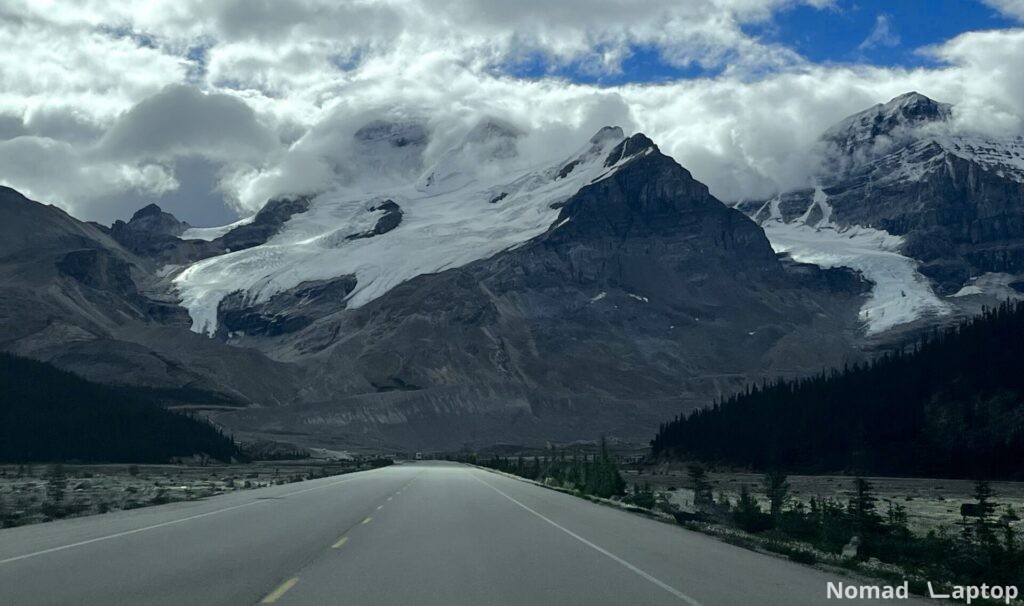
About
The Icefields Parkway (Highway 93) is a beautiful road between Jasper and Lake Louise and the primary route that cuts the Canadian Rockies in Alberta.
It is a 230-kilometer-long drive that traverses both the Jasper and Banff National Parks and is considered one of the most scenic drives in the world.
Drive
Highway 93 is a 200 km long highway between Jasper and Banff.
Impressions
The Icefields Parkway is known for being one of the most beautiful scenic roads in the world. My drive was initially “slightly” ruined by the anxiety of an empty tank and still to this day, I have no idea how I was able to reach the only gas station at 100 kilometers away with presumably 30 kilometers of gas left.
After filling up, I was able to enjoy the surroundings but unfortunately, I missed the stop at the Athabasca Glacier. Still, the title is well earned, as the scenic road was wonderful and well worth the deviation.
Peyto Lake
Peyto Lake
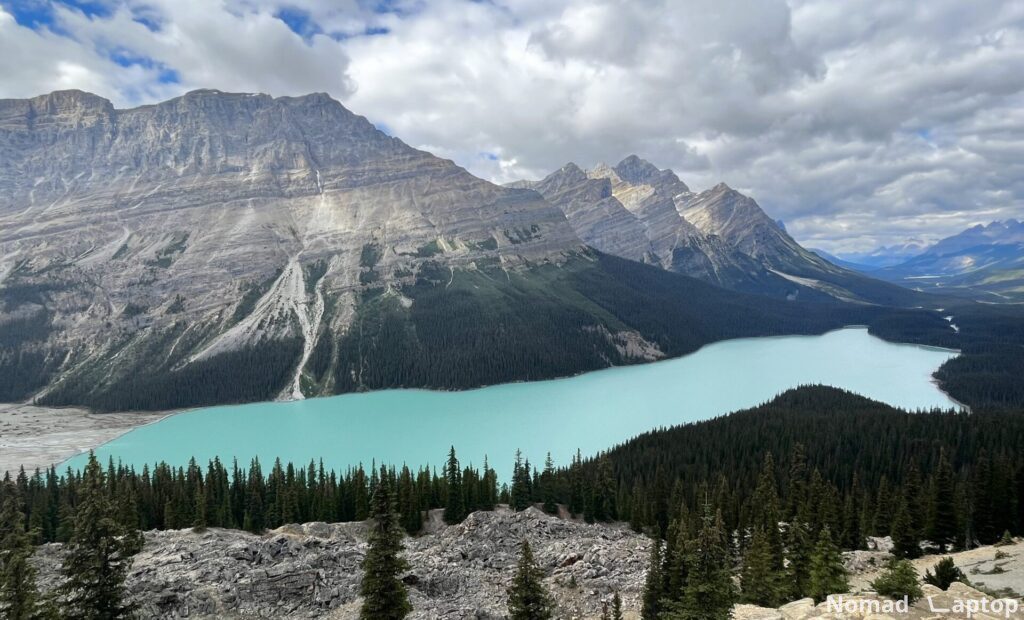
About
Peyto Lake, located within Banff National Park and standing at 1,860 m, is a large, 2.8km-long lake fed by Peyto Creek, which drains water from Caldron Lake and Peyto Glacier (part of the Wapta Icefield).
During the summer, a large amount of glacial rock flour flows into the lake, giving the lake a clear and bright azure color.
Drive
190 km south from Jasper on Highway 93.
Impressions
By now, I was no stranger to azure lakes but Peyto Lake was otherworldly and unreal. There is a short 30-minute walk to the observation deck on a paved road and when I reached it, I thought that I had been transported inside a painting.
Despite being far away and not having that connection to nature as with other lakes, the beauty of the scene is simply breath-taking.
Takakkaw Falls
Takakkaw Falls
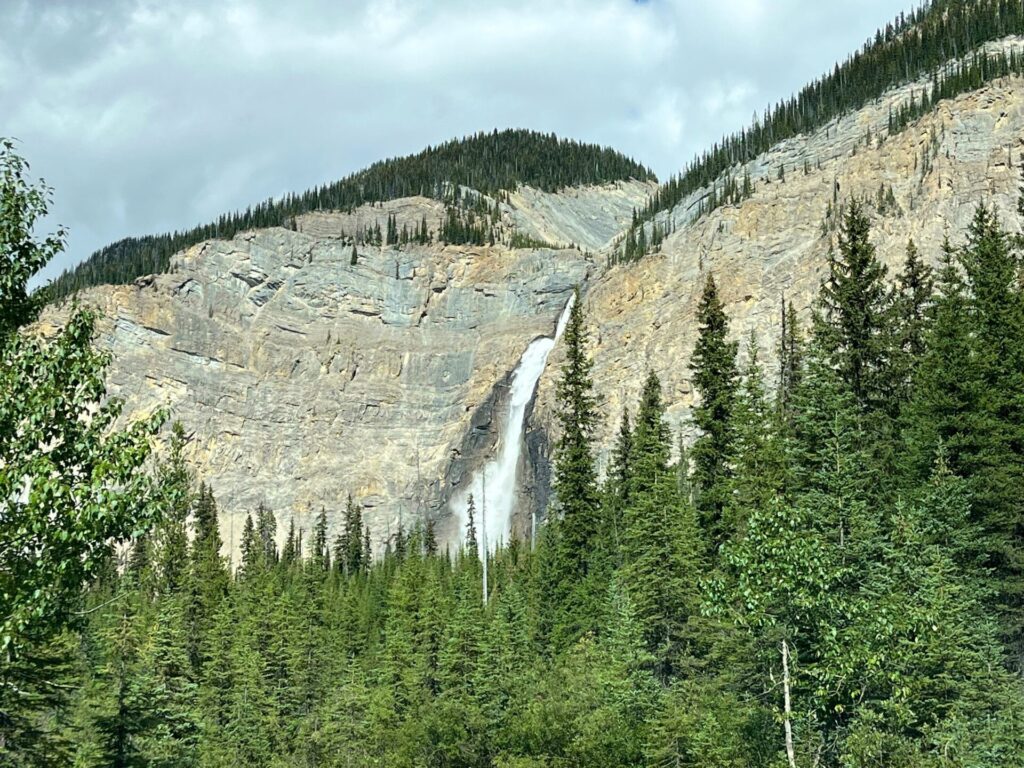
About
Takakkaw Falls is the second-tallest waterfall in Canada at 373 meters and resides within Yoho National Park. It is fed by the Daly Glacier, which is part of the Waputik Icefield.
Drive
40kms south from Peyto Lake on Highway 93.
Lake Louise
Lake Louise
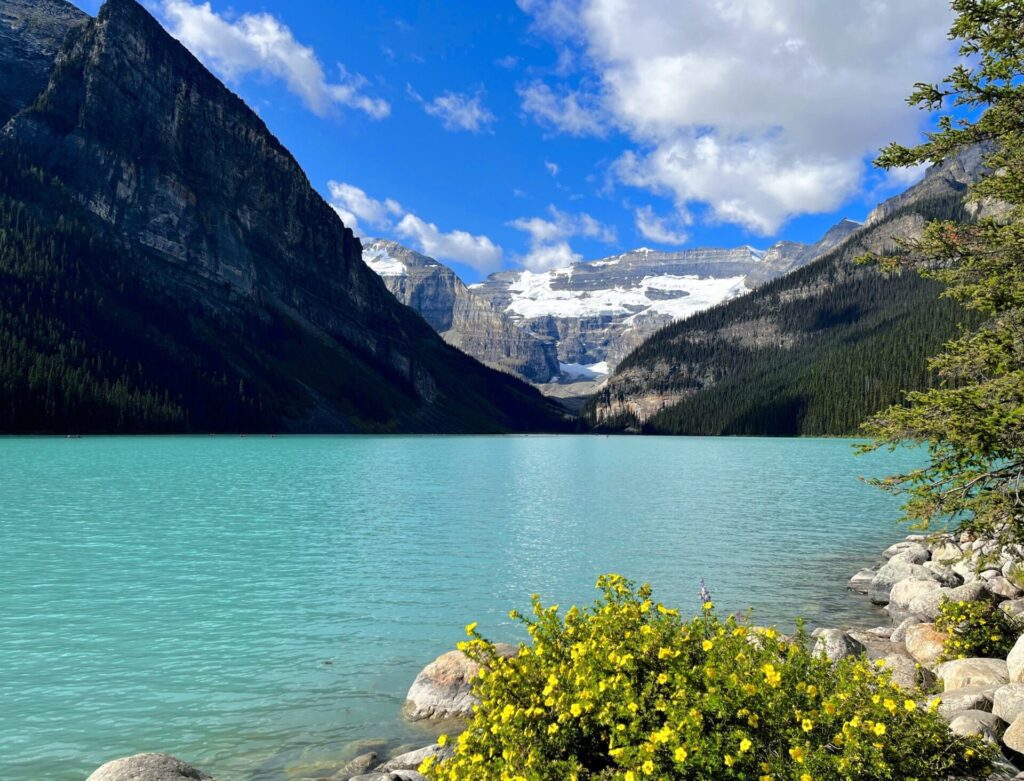
About
In the heart of Banff National Park stands the secluded Lake Louise, arguably one of the most famous lakes in the whole country. Also known as the Lake of Little Fishes, it is a famous destination for tourists and boasts the classical turquoise color given by the rock flour and
On one of its shores the beautiful luxury castle resort Châteaux Lake Louise, perched over the lake, provides even more scenery to the wonderful small lake.
Drive
50kms south from Peyto Lake on Highway 93.
Impressions
I woke up quite early and initially went to another world-known lake, Lake Moraine, but the area was already swarming with visitors. Without much hope, I therefore went to Lake Louise and was confronted with yet another example of Canadian politeness when the parking attendant first of all apologized for the complete invasion of the park by visitors, then indicated a place where I could temporarily stop, and less than a minute later she moved from her spot and approached me, telling me that someone had left and indicating where I could park.
This small lake is also incredibly beautiful and the châteaux overlooking it only adds to the wonder.
Due to its fame, the place was invaded by visitors and it made little sense to walk around in the “traffic”, so I stopped on a bench and bathed in the sun, surrounded by passersby, as one would do in a park in the center of a large city.
Accommodation
I stayed at the Mountaineer Lodge ($$$$$), a motel style lodge located directly in lake louise downtown, so to be as close as possible and beat the crowds (which I didn’t).

Banff
Banff
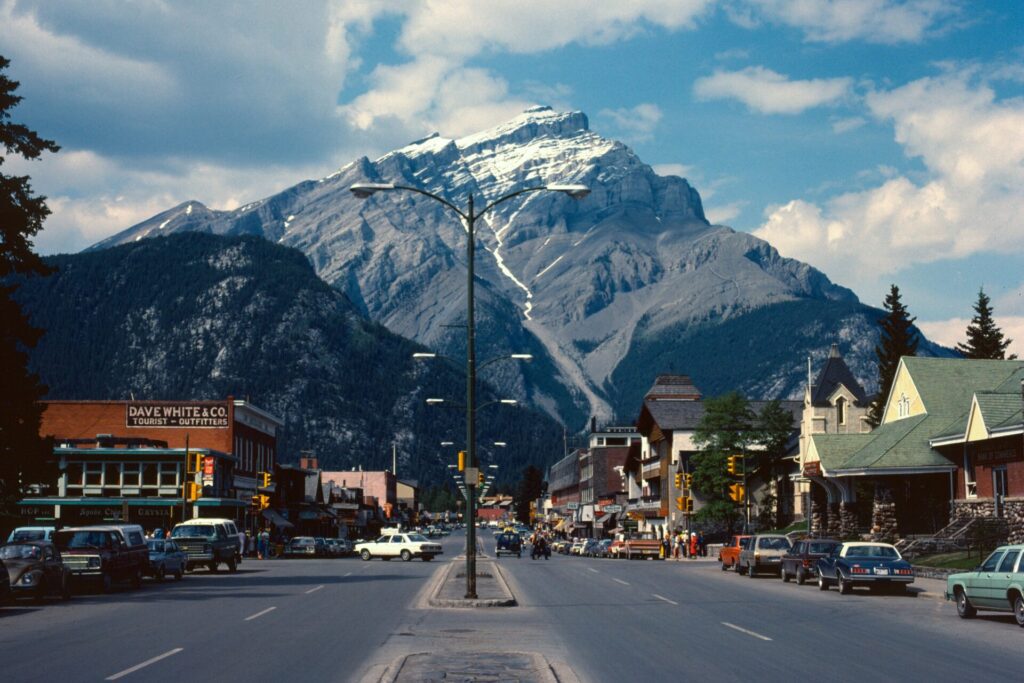
About
Banff National Park is the oldest park in Canada. In its heart stands the mountain town of Banff.
Banff is a tourist town located at an elevation of 1400 meters, making it the community with the second highest elevation in the province of Alberta in the Rockies. Banff Park is the oldest in Canada.
Like many mountain towns, Banff has a very different character in winter and summer and offers varying activities and attractions depending on the season, with great hikes and trails in summer and excellent skiing opportunities in winter.
The town is very picturesque, with a beautiful city center and a lot of wildlife roaming around the outskirts (mostly moose and deer; bears were present once but no longer “visit” the area).
Drive
60kms east of Lake Louise on Highway 1 (aka Trans-Canada Highway).
Impressions
Banff is a beautiful mountain town.
The town center is wonderful, buzzing with visitors, souvenir shops, and chain restaurants, but also wonderful, immersed in the mountains. Outside of the main streets, I saw deer peacefully grazing.
Accommodation
Banff Rocky Mountain Resort ($$$$$) is located in its own private park and minutes away from downtown Banff

Deals for Banff National Park
Bow Falls
Bow Falls

About
Bow Falls originate from the Bow River, sourced from the Bow Glacier (part of the Wapta Icefield).
They are probably the easiest waterfalls to visit, being located right within the town of Banff.
Calgary
Calgary

Drive
120kms east from Banff on Highway 1/Trans-Canada Highway.
About
Calgary is the largest city in the province of Alberta and is located just south of the Canadian Rockies at an elevation of 1045 meters.
Nicknamed Cowtown, this rodeo-mad city is one of the last frontiers of cowboy culture, hosting in the summer the Calgary Stampede, also known as the Greatest Outdoor Show on Earth.
Dubbed also the Sandstone City after a fire in 1886 burned much of the wooden homes to the ground and the city was rebuilt with sandstone from the banks of the Bow.
Calgary is an entry point to the nearby Canadian Badlands, which are not only scenic by themselves but also host the largest deposit of dinosaur fossils in the world.
For more info on Calgary check out this Article

Closing thoughts
This was almost a road trip in its purest form, with very few hikes and brief stops.
It was a sort of reconnaissance journey, trying to cross all the major parks: Garibaldi, Jasper, Yoho, and Banff, and this left me very little time to really enjoy and explore each area, but as I said in the introduction, I was in the mood to churn kilometers and traverse these immense landscapes.
I enjoyed doing this long traversal and making the long deviation north towards Jasper, passing by cities such as Kamloops, which arguably do not offer much, but the descent from Jasper on the Icefields Parkway was worth it, despite the anxiety over the lack of gas and cellular connectivity.
Now that I know what to expect, I would like to revisit all the places with more time, making a stop on Vancouver Island, which has a ton to offer, as well as go straight east on the Trans-Canada Highway and visit the areas surrounding Revelstoke, Golden, and Fields, which are also popular destinations.

